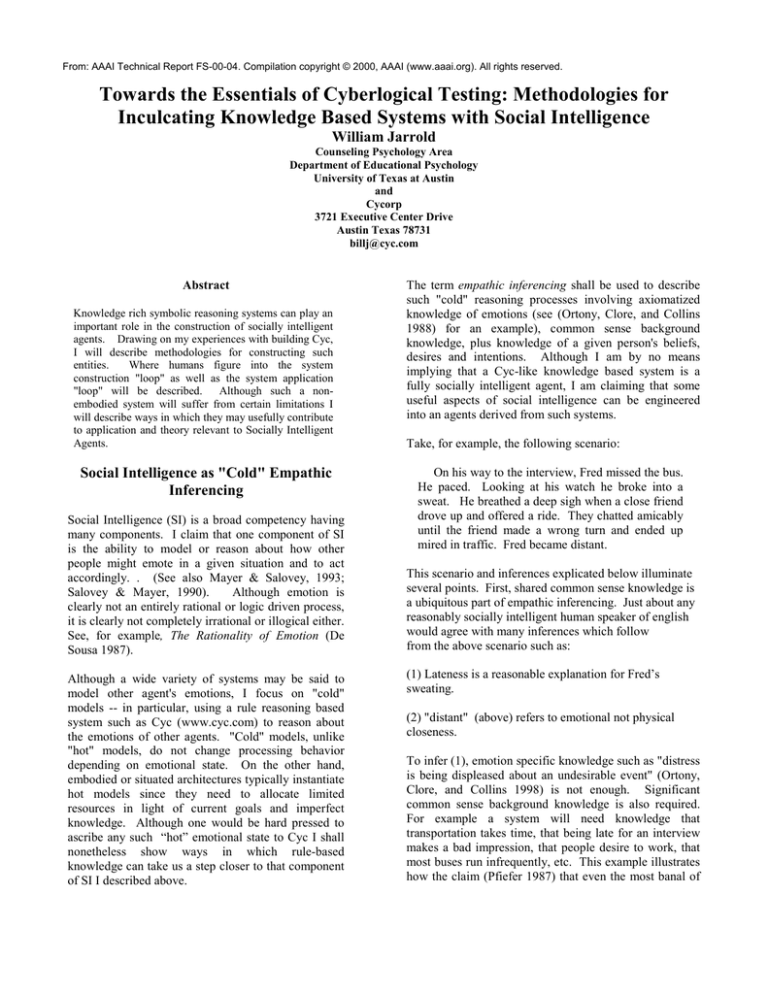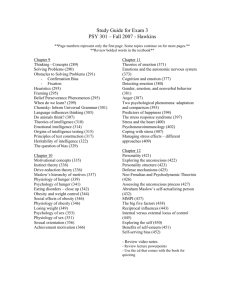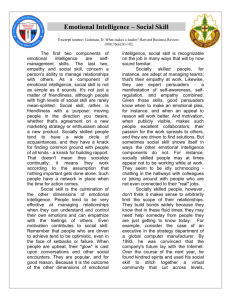
From: AAAI Technical Report FS-00-04. Compilation copyright © 2000, AAAI (www.aaai.org). All rights reserved.
Towards the Essentials of Cyberlogical Testing: Methodologies for
Inculcating Knowledge Based Systems with Social Intelligence
William Jarrold
Counseling Psychology Area
Department of Educational Psychology
University of Texas at Austin
and
Cycorp
3721 Executive Center Drive
Austin Texas 78731
billj@cyc.com
Abstract
Knowledge rich symbolic reasoning systems can play an
important role in the construction of socially intelligent
agents. Drawing on my experiences with building Cyc,
I will describe methodologies for constructing such
entities.
Where humans figure into the system
construction "loop" as well as the system application
"loop" will be described. Although such a nonembodied system will suffer from certain limitations I
will describe ways in which they may usefully contribute
to application and theory relevant to Socially Intelligent
Agents.
Social Intelligence as "Cold" Empathic
Inferencing
Social Intelligence (SI) is a broad competency having
many components. I claim that one component of SI
is the ability to model or reason about how other
people might emote in a given situation and to act
accordingly. . (See also Mayer & Salovey, 1993;
Salovey & Mayer, 1990).
Although emotion is
clearly not an entirely rational or logic driven process,
it is clearly not completely irrational or illogical either.
See, for example, The Rationality of Emotion (De
Sousa 1987).
Although a wide variety of systems may be said to
model other agent's emotions, I focus on "cold"
models -- in particular, using a rule reasoning based
system such as Cyc (www.cyc.com) to reason about
the emotions of other agents. "Cold" models, unlike
"hot" models, do not change processing behavior
depending on emotional state. On the other hand,
embodied or situated architectures typically instantiate
hot models since they need to allocate limited
resources in light of current goals and imperfect
knowledge. Although one would be hard pressed to
ascribe any such “hot” emotional state to Cyc I shall
nonetheless show ways in which rule-based
knowledge can take us a step closer to that component
of SI I described above.
The term empathic inferencing shall be used to describe
such "cold" reasoning processes involving axiomatized
knowledge of emotions (see (Ortony, Clore, and Collins
1988) for an example), common sense background
knowledge, plus knowledge of a given person's beliefs,
desires and intentions. Although I am by no means
implying that a Cyc-like knowledge based system is a
fully socially intelligent agent, I am claiming that some
useful aspects of social intelligence can be engineered
into an agents derived from such systems.
Take, for example, the following scenario:
On his way to the interview, Fred missed the bus.
He paced. Looking at his watch he broke into a
sweat. He breathed a deep sigh when a close friend
drove up and offered a ride. They chatted amicably
until the friend made a wrong turn and ended up
mired in traffic. Fred became distant.
This scenario and inferences explicated below illuminate
several points. First, shared common sense knowledge is
a ubiquitous part of empathic inferencing. Just about any
reasonably socially intelligent human speaker of english
would agree with many inferences which follow
from the above scenario such as:
(1) Lateness is a reasonable explanation for Fred’s
sweating.
(2) "distant" (above) refers to emotional not physical
closeness.
To infer (1), emotion specific knowledge such as "distress
is being displeased about an undesirable event" (Ortony,
Clore, and Collins 1998) is not enough. Significant
common sense background knowledge is also required.
For example a system will need knowledge that
transportation takes time, that being late for an interview
makes a bad impression, that people desire to work, that
most buses run infrequently, etc. This example illustrates
how the claim (Pfiefer 1987) that even the most banal of
empathic inferences requires a bevy of common sense
facts.
In sum, background common sense knowledge serves
a dual role in empathic inferencing. It allows the
system to reason about how particular "real world"
aspects of a situation relate to the beliefs, desires and
intentions of an agent. Secondly, common sense
knowledge may facilitate emotions communicated by
way of metaphor and metonomy.
Empathic
inferencing and its dependence on common sense
reasoning suggests that knowledge based systems can
play an important role in SIA's.
Applications: Can Cyc Bring Tears to
your Eyes?
Although cold-reasoners like Cyc lack bodies, I
outline several near-term SIA relevant applications
that can be envisioned.
Lacking bodies, cold model SIA's may nonetheless
leverage the sensory and visceral reality of their users.
For example, although an eyeless Cyc-like system
may never experience the depth of the Mona Lisa, it
may be able to make good guesses about appropriate
situations to retrieve such an image. The Cycorp
"Image Demo" which parses short natural language
captions and uses its knowledge base and inference
engine to semantically match these parsed captions
with a user's queries. Given propositional knowledge
about sports teams and sports fans, Cyc is capable of
reasoning that an image captioned "The New York
Yankees winning the World Series" is likely to be
significantly more pleasing to the eye of a Yankee fan
than a Red Sox fan. Thus, if a user's search query was
"Show me pleasing images" and the system knows the
user as a devout Yankee Fan, the Cycorp Image Demo
system is capable of making contextually relevant
selections.
Music selection, like image selection, can also tap
human emotion. Many of us can remember the
powerful impact of hearing a lyrical piece of music
which serendipitously match our current emotional or
interpersonal reality. For example, perhaps you are
familiar with the Beatles song "Little Black Bird in the
Dead of Night" -- the rest of the relevant lyrics are
"Take these broken wings and learn to fly". Such a
song might be particularly energizing to someone in
the throes of vegetative depression who wishes to
regain the energy and courage to socialize in public
places.
A disk jockey/diary companion SIA that knew about its
user's crisis could infer a mapping between aspects of the
user's situation and the scenario described in the lyrics.
"Little black bird" could be mapped to the user. The
bird's broken wings causal role in its inability to fly could
be analogized to the user's phobia and its role in social
disability. The bird's imperative, "Learn to fly" could be
mapped to the users desire to have a social life.
Modest success using analogy engines in the context of
knowledge based systems has already been achieved.
With continued incremental advances, systems like the
above should be realizable in a handful of years. An
ultimate Turing-level test of such a system would be if it
could bring tears to its user's eyes from time to time by
playing the right song in just the right situation, by
displaying just the right image in just the right context.
Evaluation:
Rumination
Challenge,
Regression,
and
Socially intelligent or not, continual evaluation is an
important engineering practicality of building large
knowledge bases. Unlike embodied systems, Cyc-like
systems are not of necessity faced with the vagaries and
complexities of constant interaction with the real world.
Knowledge engineers are easily lulled into the
complacency of "a bigger KB is a better KB." A partial
workaround for this weakness is to subject Cyc-like
systems to continual evaluative pressure. I describe three
means of applying this pressure: Challenge Problems,
Regression Tests, and Rumination based feedback.
As (Dautenhahn 1999) alludes if such systems are to be
socially compelling to humans, clean GOFAI problems
like chess, the traveling salesman, or the prisoner's
dilemma will not pose challenges which approximate
social reality. By the same token, if the challenge is
too difficult, the only systems that will appear to do well
are "smoke and mirror" AI systems such as Eliza which
do not possess any form of real understanding. What is
needed are challenge problems that are developmentally
appropriate or closer to what Vygotsky would refer to as
the zone of proximal development (as cited in Wertsch,
1991). There is not space in this paper to address what
constitutes such developmentally appropriate challenges.
However, it would be a good discussion topic for the
symposium.
Although developmentally appropriate challenges are
important for optimal learning, knowledge engineers must
also be vigilant for cases in which new axioms fashioned
to meet new challenges do not interfere with old axioms.
Thus, it is important to test for regression against prior
baselines after each new learning activity. In the
language of software engineering, regression tests
should be performed after each system modification.
At Cycorp we apply a battery of regression tests each
night ensures that what worked yesterday continues to
work today. With scores of knowledge engineers
adding thousands of axioms per day, new violations
are nipped in the bud nearly every day.
Thirdly, knowledge engineers must ensure that axioms
do not combine in unforeseen ways. A set of
processes that I call rumination-based quality control
can be performed as a partial check. One of several
types of this process involves formulating open-ended
queries to the inference engine.
Although not yet a part of daily activities at Cycorp
limited forays into this technique have already
produced interesting results. In one such foray the
Cyc system was asked the following question.
"Does anyone feel any emotion to any degree about
any event or any object."
In cycl the query was:
In this way, introspective or open-ended query type
testing may be used to evaluate and suggest
improvements to a knowledge-based system.
Conclusion
If the above described research is fully successfully about
the best that can be hoped for is a system which mimics
the social intelligence of a high functioning bed ridden
autistic child who reads voraciously. In spite of such
limitations work on such disembodied cold-reasoner
systems is worthwhile. In particular focused applications
or as a subcomponent of a larger system such an approach
may make for a socially compelling intelligent agent.
This paper argues that success in either endeavor can not
be achieved without a judicious adherence to the
essentials of continued evaluation and re-evaluation of
system performance during knowledge base construction.
Acknowledgements
Thanks to Diane Schallert for many helpful suggestions.
References
(#$feelsTowardsEvent ?agent ?emot ?event ?level).
There were hundreds of conclusions, the vast majority
of them were correct. For example, Cyc inferred that
Queen Elizabeth II feels loyalty towards England.
But, what was most amusing not very plausible was
that the system inferred that Hillary Clinton felt no
contempt for her husband Bill Clinton. Translating
these axioms into English the givens responsible for
this deduction were as follows:
(Axiom A) Spouses love each other.
(Axiom B) Love and contempt are contrary emotions.
(Axiom C) Bill Clinton is Hillary Clinton's spouse.
Although each one of them may appear more or less
correct standing by itself, when chained together they
led to a conclusion which most people would rank as
false. The are several possible repairs for such a
deduction:
(1) Split apart the concept #$Love into at least two
forms (a) an in the moment feeling inconsistent
with contempt (b) a long-term affective
disposition frequently felt by spouses.
(2) Add an exception condition to (Axiom A).
Spouses love each other except in cases of adultery.
Describe the Monica Lewinsky story to Cyc.
Dautenhahn, K. 1999. The Lemur's Tale - Story-Telling in
Primates and Other Socially Intelligent Agents.
"Narrative Intelligence", AAAI Fall Symposium 1999,
chairs: Phoebe Sengers and Michael Mateas.
De Sousa, R. 1988. The Rationality of Emotion
Cambridge Mass:MIT Press.
Mayer, J.D. & Salovey, P. 1993. The intelligence of
emotional intelligence. Intelligence, 17, 433-442.
Ortony, A., Clore, G. and Collins, A. 1988. The Cognitive
Structure of Emotions. New York:Cambridge University
Press.
Pfeifer, R. 1987. Artificial Intelligence Models of
Emotion. In Hamilton V., Bower, G. H., and Frijda, N.
H., eds Cognitive Perspectives on Emotion and
Motivation. Boston: Kluwer Academic Publishers. p.287320.
Wertsch, J. V. (1991). A sociocultural approach to
socially shared cognition. In L. B. Resnick, J. M. Levine,
& S. D. Teasley (Eds.), Perspectives on socially shared
cognition, pp. 85-100. Washington, DC: American
Psychological Association.






